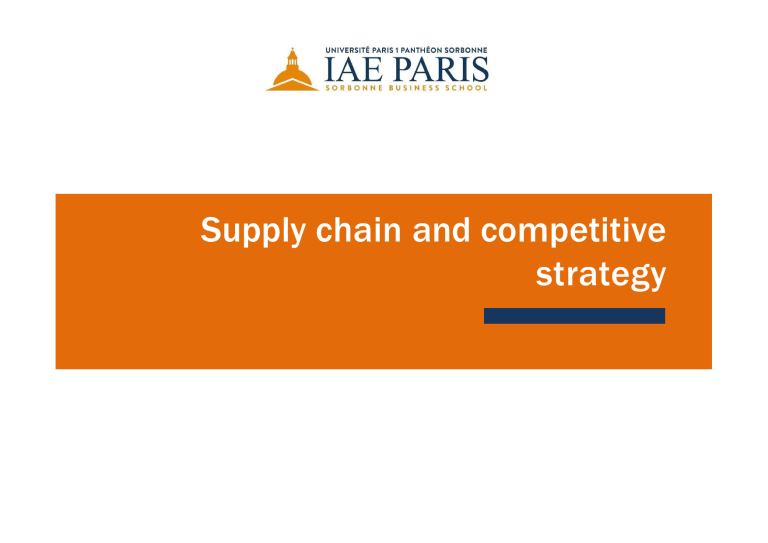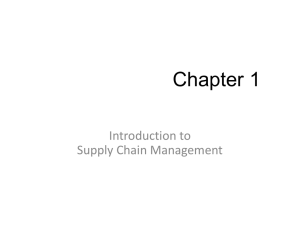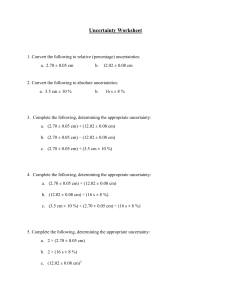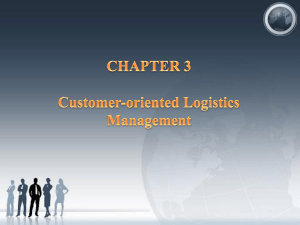
Supply chain and competitive strategy SCM and competitive advantage • Effective logistics and supply chain management can provide a major source of competitive advantage – Cost advantage: logistics and scm can increase efficiency and productivity (leaning curve) – Value advantage: segmentation (value segments), service (process of developping relatioships with customers through the provision of an augmented offer). Competitive advantage and the ‘Three Cs’ Customers Needs seeking benefits at acceptable prices Assets and utilisation Cost differentials Company Source: Ohmae, K., The Mind of the Strategist, Penguin Books, 1983 Assets and utilisation Competitor Supply chain excellence High Relative Differentiation Low High Low Relative Delivered Cost Gaining competitive advantage through logistics Value Advantage Logistics Leverage Opportunities: • Tailored service • Reliability • Responsiveness, etc The goal: superior customer value at less cost Cost Advantage Logistics Leverage Opportunities: • Capacity utilisation • Asset turn • Schedule integration The supply chain becomes the value chain • Competitive advantage cannot be understood by looking at a firm as a whole… • The value chain disaggregates a firm into strategically relevant activities in order to understand the behaviour of costs and the existing and potential sources of differenciation. • Implication: organisations should look at each activity and assess wether they have a real competitive advantage in the activity. If not, they should consider outsourcing that activity. The value chain Firm infrastructure Human resource management Support activities Technology development Inbound logistics Operations Outbound logistics Margin Procurement Marketing & sales Services Primary activities Source: Reprinted with the permission of The Free Press, a division of Simon & Schuster, Inc. from Competitive Advantage by Porter, M.E. Copyright © 1985 by Porter, M. E. All Rights reserved The supply chain and competitive performance The supply chain is the network of organizations that are involved in the different processes and activities that produce cost and value in the form of product and services in the hand of the consumer. Achieving Strategic Fit • Strategic fit – competitive and supply chain strategies have aligned goals • A company may fail because of a lack of strategic fit or because its processes and resources do not provide the capabilities to execute the desired strategy Achieving Strategic Fit 1. The competitive strategy and all functional strategies must fit together to form a coordinated overall strategy. Each functional strategy must support other functional strategies and help a firm reach its competitive strategy goal. 2. The different functions in a company must appropriately structure their processes and resources to be able to execute these strategies successfully. 3. The design of the overall supply chain and the role of each stage must be aligned to support the supply chain strategy. How is Strategic Fit Achieved? 1. Understanding the customer and supply chain uncertainty 2. Understanding the supply chain capabilities 3. Achieving strategic fit Step 1: Understanding the Customer and Supply Chain Uncertainty • • • • • • Quantity of product needed in each lot Response time customers will tolerate Variety of products needed Service level required Price of the product Desired rate of innovation in the product Step 1: Understanding the Customer and Supply Chain Uncertainty • Demand uncertainty – uncertainty of customer demand for a product • Implied demand uncertainty – resulting uncertainty for the supply chain given the portion of the demand the supply chain must handle and attributes the customer desires Customer Needs and Implied Demand Uncertainty Customer Need Causes Implied Demand Uncertainty to … Range of quantity required increases Increase because a wider range of the quantity required implies greater variance in demand Lead time decreases Increase because there is less time in which to react to orders Variety of products required increases Increase because demand per product becomes less predictable Number of channels through which product may be acquired increases Increase because the total customer demand per channel becomes less predictable Rate of innovation increases Increase because new products tend to have more uncertain demand Required service level increases Increase because the firm now has to handle unusual surges in demand TABLE 2-1 Impact of Supply Source Capability Supply Source Capability Frequent breakdowns Causes Supply Uncertainty to... Increase Unpredictable and low yields Increase Poor quality Increase Limited supply capacity Increase Inflexible supply capacity Increase Evolving production process Increase TABLE 2-3 Implied Uncertainty (Demand and Supply) Spectrum FIGURE 2-2 Step 2: Understanding Supply Chain Capabilities • How does the firm best meet demand? • Supply chain responsiveness is the ability to – Respond to wide ranges of quantities demanded – Meet short lead times – Handle a large variety of products – Build highly innovative products – Meet a high service level – Handle supply uncertainty Step 2: Understanding Supply Chain Capabilities • Responsiveness comes at a cost • Supply chain efficiency is the inverse to the cost of making and delivering the product to the customer • The cost-responsiveness efficient frontier curve shows the lowest possible cost for a given level of responsiveness Cost-Responsiveness Efficient Frontier FIGURE 2-3 Responsiveness Spectrum FIGURE 2-4 Step 3: Achieving Strategic Fit • Ensure that the degree of supply chain responsiveness is consistent with the implied uncertainty • Assign roles to different stages of the supply chain that ensure the appropriate level of responsiveness • Ensure that all functions maintain consistent strategies that support the competitive strategy Efficient and Responsive Supply Chains Efficient Supply Chains Responsive Supply Chains Primary goal Supply demand at the lowest cost Respond quickly to demand Product design strategy Maximize performance at a minimum product cost Create modularity to allow postponement of product differentiation Pricing strategy Lower margins because price is a prime customer driver Higher margins because price is not a prime customer driver Manufacturing strategy Lower costs through high utilization Maintain capacity flexibility to buffer against demand/supply uncertainty Inventory strategy Minimize inventory to lower cost Maintain buffer inventory to deal with demand/supply uncertainty Lead-time strategy Reduce, but not at the expense of costs Reduce aggressively, even if the costs are significant Supplier strategy Select based on cost and quality Select based on speed, flexibility, reliability, and quality TABLE 2-4 Agile or lean? High “Agility” is needed in less predictable environments where the demand for variety is high. AGILE Variety/ Variability LEAN Low Low High Volume per variant “Lean” works best in high volume, low variety and predictable environments. Demand/supply characteristics determine supply chain strategy Long lead-times Lean Plan & optimise Hybrid De-couple through postponement Supply characteristics Short lead-times Kanban Continuous replenishment Agile Quick response Predictable Unpredictable Demand characteristics The decoupling point Lean Agile ● Forecast at generic level ● Demand driven ● Economic batch quantities ● Localised configuration ● Maximise efficiencies ● Maximise effectiveness Strategic Inventory The agile supply chain • Market sensitive: supply chain is capable of reading and responding to real demand (direct feed-back from the marketplace), instead of forecast driven. • Virtual: information based rather than inventory based (e commerce, internet) • Process alignment: collaborative working between buyers and suppliers, joint product developement, common systems and shared information (cooperation) • Network based supply chain: individual companies compete as supply chain The agile supply chain Virtual Market sensitive Agile supply chain Network based Process alignment Route map to the responsive business Economies of scale Synchronized production Waste reduction Lean production Capacity management Vendor managed inventory Standardization/ modularization Agile supply Flexible response De-couple the supply chain Process management The Responsive Business Organizational agility Setup time reduction Non-value-adding time reduction Quick response Demand driven Process re-engineering Visibility of real demand Cross-functional teams Continuous replenishment programmes The four pillars of supply chain excellence Supply Chain Excellence Responsiveness Reliability Resilience Relationships Responsiveness : Time-based competition is now the norm. The focus is on agility. Organisations must be much more demand-driven than forecastdriven Reliability : Unreliable processes create uncertainty and variability. Equally, lack of visibility adds to uncertainty. Resilience : Today’s turbulent and volatile markets require supply chains that are capable of dealing with the unexpected and the unplanned. Relationships : As supply chains become more complex and as outsourcing increases dependency on suppliers, the need for relationship management increases. Understanding strategic fit 31 STRATEGIC LEAD TIME MANAGEMENT Time is money • Long lead time means – Costs: direct relationship between the length of the logistic pipeline, inventory and inventory costs – Slower response to customer requirements • Customers are more and more time-sensitive • Time sensitive markets: – Shortening life cycles – Customers’ drive for reduced inventories – Volatile markets making reliance on forecasts dangerous. Shortening life cycles • Time-to-market is important • Once the product is on the market, the ability to respond quickly to demand is also important – Capacity to exploit demand during the life cycle – When the order-to-delivery cycle is reduced, companies can have a strong advantage over their slower competitors. Shorter life cycles make timing crucial Market Sales Late Entrant Obsolete stock Time • Less time to make profit • Higher risk of obsolescence Customers’drive for reduced inventories • Companies reduce their inventories: – Reduced capital and holding costs – Improved flexibility and responsiveness to their customers. • Suppliers are supposed to provide a JIT delivery service, without carrying the inventory burden instead of the customer. • Time compression can enable companies to break free of the classic trade-off between service and costs. Breaking free of the classic service/cost trade-off Time compression Service enhancement Cost reduction Volatile markets make reliance on forecasts dangerous • Demand volatility is tending to increase due to customers and competition. • Very few forecasting methods will be able to predict short-term changes in demand • Solutions: – Increasing the safety stock – Reducing throughput times. The concept of lead-time • Order to delivery (OCT: order cycle time) – Components of the OCT • Cash-to-Cash cycle: how long is the pipeline from the sourcing of raw materials through to the finished product? The pipeline consume resources and and needs to finance working capital. The order cycle Customer places order Order entry Order processing Order assembly Transport Source: Stock, J.R and Lambert, D.M., Strategic: Logistics Management, 2nd edition, Irwin, 1987 Order received How long is the logistics pipeline? Cumulative Lead-Time (Procurement to Payment) Raw Material Stock Sub-Assembly Stock Intermediate Stock Product Assembly Finished Stock at Central Warehouse In-Transit Regional Distribution Centre Stock Customer Order Cycle (Order-Cash) Logistics pipeline management • Goals of logistics pipeline management: – – – – Lower costs Higher quality More flexibility Faster response times. • How fast does the pipeline add value? – Increasing the ratio of value-added to cost-added time Which activities add cost and which add value? Finished Product Production ValueAdded Time, Place & Form Utility InTransit Regional Customer Order Stock Cycle Raw Material Stock Cost-Added Production, Storage & Transport costs & the Time Cost of Money Reducing non-value-adding time improves service and reduces cost Finished Stock Regional Stock Customer Delivery InTransit Raw Material Stock Valueadding time Production Production Finished Stock InTransit Cost-adding time Raw Material Stock Regional Stock Customer Delivery SCM as major strategic variable • Achievement of competitive advantage through excellence in logistics and supply chain management: logistics and supply chain management as major strategic variables • Some companies have invested in developping logistics capability (Gartner study) – – – – – Demand-driven Embedded innovation Close relationships from end-to-end (extended supply chain) Balanced metrics Culture (removal of internal silos, pertnering for external relationships) – Supply chain talent: developping skills and capabilities Network competition • Network organisations: individual businesses no longer compete as stand-alone entities. • Virtual organisations: confederation of specialist skills and capabilities provided by the network members, collaborative arrangement. • High level of co-operation between organisations in the network, creating visibility in the pipeline, integration – Sharing of information – Seamless processes • From a transactional business model to a partnering business model (developping long-term relationship based on mutual confidence) Cost reduction through collaboration • Gaining internal efficiences….but often simply transferring costs upstream or downstream • Cost reduction opportunities through collaboration: – Transaction costs: costs of placing orders, raisin invoices, confirming delivery arrangements… can be lowered if barriers to collaboration can be removed – Process costs: when suppliers’ processes do not align with those of their customers (different product codes, different pallet sizes….) – Uncertainty costs: without supplier/customer communication, safety stocks are necessary at the interfaces • Managing the supply chain as a network: – Collective strategy developement – Co-operation thinking – Open communication: advent of IT systems, Open-book accounting Co-creation in the supply chain Extended Enterprise Focus on splitting the pie Focus on expanding the pie Value to Customer Value to Customer Traditional Relationship Value to Supplier Source: J.H. Dyer, Collaborative Advantages Value to Supplier Contact : Nom ou service Téléphone Mail




